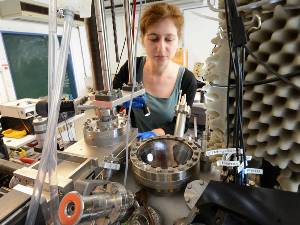Aug 14 2014
Dr. Wilhelm Auwärter and his team are working on a research project to develop tiny flat molecule tapes at the Department of Physics of Technische Universität München (TUM). These structures could find versatile applications. Via direct coupling on a silver surface, the scientists successfully formed dimers and short chains of porphine molecules without contaminating by-products.
 Alissa Wiengarten, PhD student at the TUM Department of Physics, heats a porphine powder in a vacuum chamber. (Photo: Thorsten Naeser/Munich-Centre for Advanced Photonics)
Alissa Wiengarten, PhD student at the TUM Department of Physics, heats a porphine powder in a vacuum chamber. (Photo: Thorsten Naeser/Munich-Centre for Advanced Photonics)
Porphyrin molecules are essential to many biological processes, such as photosynthesis and respiration. Dr. Wilhelm Auwärter's group is investigating these all-round talents at TU München. Normally, hydrogen attaches to the outer edges of the porphyrin core – named porphine, but other chemical entities can take the place of hydrogen, thereby changing the properties of the molecules.
Alissa Wiengarten, PhD student at the TUM Department of Physics, heats a porphine powder in a vacuum chamber. In the process, individual porphine molecules leave the collective and adhere to a silver surface, where they react with each other and assemble into small groups – all by themselves. Single molecules can desorb from the hot surface, while chains of two, three or more porphine units cannot. In this way the scientists were able to assemble chains of up to 90 porphine units.
Thorough analysis
Using a surface made of silver is essential to the experiment: "Silver seems to be a kind of catalyst for the reaction", Wilhelm Auwärter explains. "Still, we don't fully understand why this is the case."
Aside from fundamental questions, Auwärter’s group also hopes to find a way to generate ordered long molecular porphin chains, so-called tapes. Only one molecule wide, such structures could serve as optically active elements in electronic applications or data storage.
In order to investigate these tiny structures on the silver surface, Auwärter's team uses a whole range of sophisticated structure analysis techniques available at TUM and through cooperation with international partners.
Fascinating images of the molecular structures, for example, were captured using a scanning tunneling microscope at TUM. The team also conducted spectroscopy analyses using synchrotron radiation of the ELETTRA storage ring in Trieste, which provided important insights into the electronic structure of the porphine groups.
About the project:
The work was funded by the ERC (Advanced Grant MolArt), by the German Research Foundation (DFG) (Cluster of Excellence Munich Center for Advanced Photonics (MAP) and Technische Universität München’s Institute for Advanced Study), a Marie Curie Intra-European Fellowship and the International Max Planck Research School of Advanced Photon Science (IMPRS-APS), as well as the Japanese International Center for Young Scientists (ICYS) and the International Center for Materials Nanoarchitectonics (MANA). The synchrotron experiments were carried out at the Helmholtz-Zentrum Berlin’s electron storage ring BESSY II and the Materials Science Beamline of the synchroton facility ELETTRA in Trieste (Italy).
Publication:
"Surface-assisted Dehydrogenative Homocoupling of Porphine Molecules" Alissa Wiengarten, Knud Seufert, Willi Auwärter, David Ecija, Katharina Diller, Francesco Allegretti, Felix Bischoff, Sybille Fischer, David A. Duncan, Anthoula C. Papageorgiou, Florian Klappenberger, Robert G. Acres, Thien H. Ngo and Johannes V. Barth
J. Am. Chem. Soc. 2014, 136, 9346−9354 – DOI: 10.1021/ja501680n